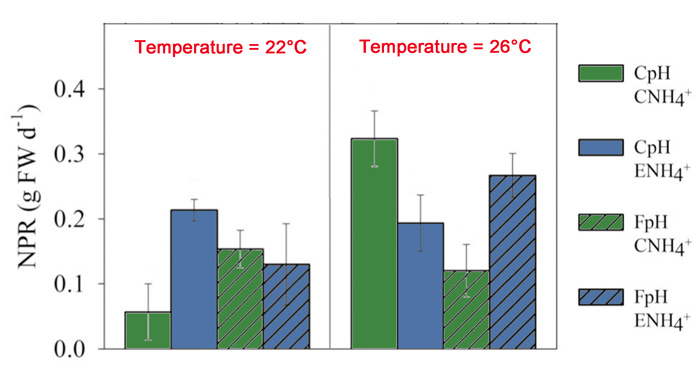| Tweet | Follow @co2science |
Paper Reviewed
Egea, L.G., Jiménez-Ramos, R., Vergara, J.J., Hernández, I. and Brun, F.G. 2018. Interactive effect of temperature, acidification and ammonium enrichment on the seagrass Cymodocea nodosa. Marine Pollution Bulletin 134: 14-26.
Coastal vegetated ecosystems are increasingly recognized for their importance as keystone habitats, where they are considered among the richest and most relevant ecosystems worldwide. Concerns over the health and vitality of these ecosystems, however, has spurned research into their potential responses to multiple stressors associated with predicted global climate change and local anthropogenic factors.
The latest group to conduct research in this area was that of Egea et al. (2018), who examined the interactive effects of warming, ocean acidification and ammonium enrichment on the coastal seagrass Cymodocea nodosa. In doing so, they collected seagrass samples from meadows in Cadiz Bay, southern Spain, which were transported to, and thereafter grown, in an open-water indoor mesocosm system at the Faculty of Marine and Environmental Sciences of the University of Cadiz. Treatment conditions at the facility included two temperature levels (22 or 26°C), two seawater pH levels (8.21 or 7.69) and two ammonium levels (control and an additional 31µM NH4+) over a four-week experimental period.
With respect to their findings, Egea et al. report that ammonium addition, whether alone or in combination with temperature and/or pH, "did not have a negative effect at the whole plant level (i.e., survival or plant production rates), since [observations revealed] a slight stimulation of net production when compared with the control treatment." Reduced seawater pH, by itself, did not have much of an impact on seagrass growth either. Temperature impacts, on the other hand, were a different story. According to the authors, "overall, net production rate [(NPR, grams of fresh weight per day)] increased significantly under high temperature treatments and also under the combination treatment of the three factors" (see Figure 1 below). In this regard Egea et al. report that the combined high temperature, control pH and control ammonium treatment experienced NPR values that were "2.4 times higher than the average of the other treatments," whereas the combined high temperature, reduced pH and elevated ammonium treatment experienced NPR values "2 times higher than the average of the other treatments."
In commenting on their work, the authors say that "although some of the environmental factors studied in this experiment may produce a limited response in Cymodocea nodosa when acting alone (CO2 increase and NH4+ enrichment), the combined effect of the three factors triggered a positive response of this seagrass species. Continuing, they add that "overall productivity was improved in this species, as were nonstructural carbohydrate concentrations, which may improve plant resistance to other stressors." Thus, Egea et al. "predict a positive response of C. nodosa to the forecasted future conditions of warmer temperature, NH4+ enrichment and CO2 increase as their productivity was enhanced without decreasing non-structural carbohydrates reserves, which are essential when environmental conditions become more stressful." And given that prediction, they say "it seems that climate change and to some extent nutrient enrichment in coastal areas may not be so detrimental to seagrasses as previously believed."

Figure 1. Net production rate (NPR) of Cymodocea nodosa at two temperature treatments (22 and 26°C), under normal (8.21; CpH) or reduced (7.69; FpH) seawater pH, and normal (no added ammonia; CNH4+) or elevated (an extra 31µM ammonia; ENH4+) ammonium. Adapted from Egea et al. (2018).




